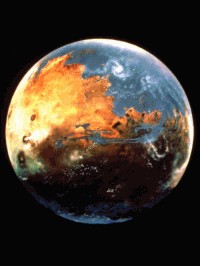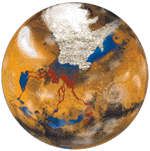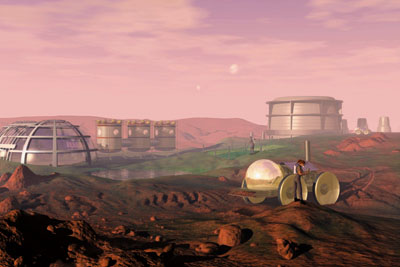| "There is nothing
more difficult to take in hand, more perilous to conduct,
or more uncertain in its success than to take the lead
in the introduction of a new order of things."
-Jean-Jacques Rousseau, 1712-78
Could people
live freely on Mars one day? Today, Mars is a frozen
desert with a carbon dioxide atmosphere that is too
thin for liquid water to exist. Water may however, exist
deep underground in subsurface
aquifers. Spacecraft images show what appear
to be flood channels and valley networks which may be
billions of years old, originating in a time when liquid
water flowed across the surface of Mars.
In that time, Mars would have possessed
a thicker atmosphere and its climate and environment
were more like Earth's. So, where did the atmosphere
and all the water go? What caused the environment to
change? Could we change it back again? Could we make
Mars a warm, wet, habitable planet like Earth? This
process is called terraforming (terra = Earth).
The first task would be to thicken
the Martian atmosphere. Much of the ancient Martian
atmosphere and water are believed to have been frozen
into the Martian polar caps as the planet cooled off
over time. The ice caps are composed of dry ice (frozen
carbon dioxide) and water ice. Some of the atmosphere
may be in permafrost below the surface. How could we
evaporate the ice caps into the atmosphere and begin
to increase the temperature? Both water and carbon dioxide
are greenhouse gases. That is, they trap heat
from sunlight, which would increase the surface temperature.
This would begin a cycle that would melt more ice, warm
the planet, and increase both air pressure and temperature.
The process could become self-sustaining and could lead
to a runaway greenhouse effect. Even though it would
increase the amount of carbon dioxide in the atmosphere,
this is a mandatory step towards increasing atmospheric
pressure and density. See a series
of images showing the greening of Mars from the
IMAX film, Destiny in Space.
The sunlight that hits a planet's surface arrives primarily as visible
and ultraviolet light. The planet absorbs this solar energy, and then
radiates warming infrared energy back out into the atmosphere. Greenhouse
gases in the atmosphere work as a global layer of insulation, trapping
that infrared radiation and preventing it from escaping into space.
But, how could we accomplish this?
In the 1970's, astronomer Carl Sagan suggested covering
the polar caps with dark material - such as carbon black
from a pulverized asteroid - to a depth of 1 millimeter.
Sagan estimated that over 100 million tons (or a 600-meter
asteroid) would be necessary to cover the ice caps.
This cover would have to be replaced each year due to
frequent dust storms. Since this would be a very arduous
task, Sagan also proposed using plants that are capable
of growing on ice.
 In
the 1980's, Planetary scientist Chris McKay suggested
that we could seed the Martian polar caps with green
plants or genetically engineered microbes that extract
the liquid water they need from ice. These organisms
would be dark and, thus, would absorb more sunlight
that would warm up the ice and increase the overall
rate of evaporation. If the surface temperature was
high enough, more carbon dioxide might be released from
the Martian soil, permafrost, and polar ice and would
flood the lowlands. This process could take from 100
to 10,000 years. In
the 1980's, Planetary scientist Chris McKay suggested
that we could seed the Martian polar caps with green
plants or genetically engineered microbes that extract
the liquid water they need from ice. These organisms
would be dark and, thus, would absorb more sunlight
that would warm up the ice and increase the overall
rate of evaporation. If the surface temperature was
high enough, more carbon dioxide might be released from
the Martian soil, permafrost, and polar ice and would
flood the lowlands. This process could take from 100
to 10,000 years.
The benefit of using plants or microbes is that they are self-reproducing.
Research has shown that some microbes can survive in a simulated Martian
environment, similar to Earth's polar regions. Such organisms could
spread out over the ice caps in a relatively short time. This process
would take a few hundred years to free the ancient atmosphere of Mars.
The increased surface pressure and temperature would then allow liquid
water to condense on Mars. There would be rain, rivers, and perhaps
even oceans. Other green plants would grow on Mars, getting nutrients
from the soil and carbon dioxide from the air just as they do here
on the Earth.
 In
1989, scientist Martyn Fogg suggested carbon dioxide
might be located in its carbonate rocks. He suggested
using 10 million fusion bombs to vaporize the rocks
and free the carbon dioxide. In 1992, scientist
Paul Birch suggested building large mirrors and lenses
in space to reflect sunlight onto the Martian ice caps
melting them. In
1989, scientist Martyn Fogg suggested carbon dioxide
might be located in its carbonate rocks. He suggested
using 10 million fusion bombs to vaporize the rocks
and free the carbon dioxide. In 1992, scientist
Paul Birch suggested building large mirrors and lenses
in space to reflect sunlight onto the Martian ice caps
melting them.
Releasing
large amounts of chlorofluorocarbons (greenhouse gases)
by the use of factories on the surface of Mars is another
possibility. Some scientists suggest this process could
take 100,000 years.
The introduction of green plants would remove some of the carbon
dioxide and they would give off oxygen, but it would take many thousands
of years to build up enough oxygen to make the atmosphere on Mars
breathable for humans and animals. The oxygen would produce an ozone
layer protecting the surface from solar ultraviolet rays. Animals
and insects could then be introduced to the environment.

Once most of the atmosphere of Mars was restored, the air pressure
would be high enough to allow people to walk around without space
suits. We still might need oxygen tanks and respirators (similar to
scuba gear), however, because we can't breathe carbon dioxide. The
thick atmosphere would shield the surface from cosmic radiation. We
also would still need to protect our skin and eyes against ultraviolet
rays from the Sun because the atmosphere would not have any ozone
layer to shield us such as ours on Earth does.
To find out if terraforming is even possible, we need to learn a
lot more about Mars. Is there enough atmosphere frozen on Mars? If
so, can it be freed? If we find that Mars has life, would we want
to leave the planet as it is and not interfere with it? If Mars turns
out to be lifeless, we might decide to terraform it and become not
only Earthlings but also Martians.
For more on terraforming Mars, check
out some of these links:
Images
of a terraformed Mars
Terraforming
Home Page
What about life on Mars?
On August 7, 1996, a team of scientists lead by David McKay at NASA's
Johnson Space Center in Houston, Texas, announced their discovery
of microscopic evidence of possible Martian fossil life in a meteorite
recovered from Antarctica. How might this affect future Mars exploration
and settlement? What are the practical and ethical issues of the discovery
of life on Mars? What should our course of action be toward possible
Mars life? How much time and effort should we make towards searching
for life before we declare Mars to be lifeless? Martian life could
be almost anywhere.
We will need to decide, as a planet, how long we should spend searching
Mars for evidence of life. What about contamination if life does exist
on Mars? Humans on Mars will be exposed eventually to any Martian
life that exists. Returning spacecraft and astronauts could also introduce
alien organisms to Earth. Many scientists think it is unlikely that
independently evolved Mars life would have enough in common with life
on Earth to cause harm; but it is impossible to know for certain.
What about
our contamination of Mars? People and unsterilized robots
will contaminate Mars with terrestrial organisms. Even
if we are willing to risk our own lives, what about
the rights of the Martians? If we did contaminate Mars
with terrestrial microbes, that could complicate studies
of any life that was found later on Mars.
The author
Mark Lupisella, in 1997, wrote in an issue of Space
Policy, "Could we forgive ourselves if we caused
the extinction of the first extraterrestrial species
we came into contact with?".
Questions to think about:
- Which
method of terraforming do you think is most viable?
Why?
- Do you
think we should consider changing the environment
of Mars at all? Why or why not?
- What
do you think a plan for determining whether there
is life on Mars should be?
- If microbial
life was discovered on Mars, do you think that humans
should not colonize the planet? Why or why not?
Next... Mission |